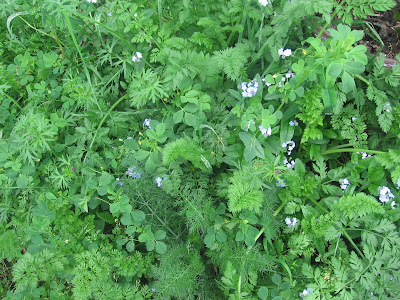
Late rains have added a burst of energy to the already luxuriant weed growth. This photo shows the main garden path in mid-April: a jungle of arugula, mallow, henbit, burr clover, miner's lettuce, grasses, sow thistle, sticky willy, bindweed and other upstarts I haven't learned to identify yet.
I left it to grow unchecked because of the preponderance of arugula -- the tall plants with white flowers. We eat the flavorful leaves in salad almost every night so it seems a small sacrifice to have the main path, which is usually wide enough and more for a garden cart to pass, reduced to a barely visible trail through the undergrowth.

In this close-up I can see fennel, forget-me-not, gopher weed, burr clover, and what I think is Queen Ann's lace. Since reading Michael Pollen's chapter on weeds in his early book, Second Nature, I've come to have a grudging admiration for these entrepreneurial pioneers that move in wherever we gardeners disturb the soil, unwittingly creating the conditions these plants are looking for. Our common garden weeds are not representatives of wild nature into which our cultivated patches are inserted. They appear as a result of our efforts to clear and dig. It seems their job is to cover up bare ground, which Mother Nature avoids as strongly as she abhors a vacuum.
So I take a fairly laissez faire approach to the garden paths -- letting the "good" weeds grow (forget-me-nots, poppies, arugula, miner's lettuce, Queen Ann's lace) and letting the "bad" weeds grow along with them until it gets to be time to get serious about the summer garden.

In a few areas where it was mostly "bad" weeds starting to come up thickly back in February, I covered the ground with lots of folded newspaper before they got tall. Unsightly but useful, the newspaper made a good base for collecting the mounds of weeds that I did manage to pull up. (You have to keep your wits about you walking around this garden in the spring: threading through jungles, avoiding piles of decaying greenery.)
Last week, when I thought the rains might be done for the season, I pulled up the newspapers to clear the paths. Above is a scenic view of a cleared path. During the long dry season it will be a hard-packed track where only bindweed and some hardy grasses like to grow.

And here is a not-so-scenic view in the back corner: the half-composted newspapers make a good layering material for starting a new brush pile. Over several years, the pile will decompose and transform the heavy black clay beneath it into fluffy soil.
No comments:
Post a Comment